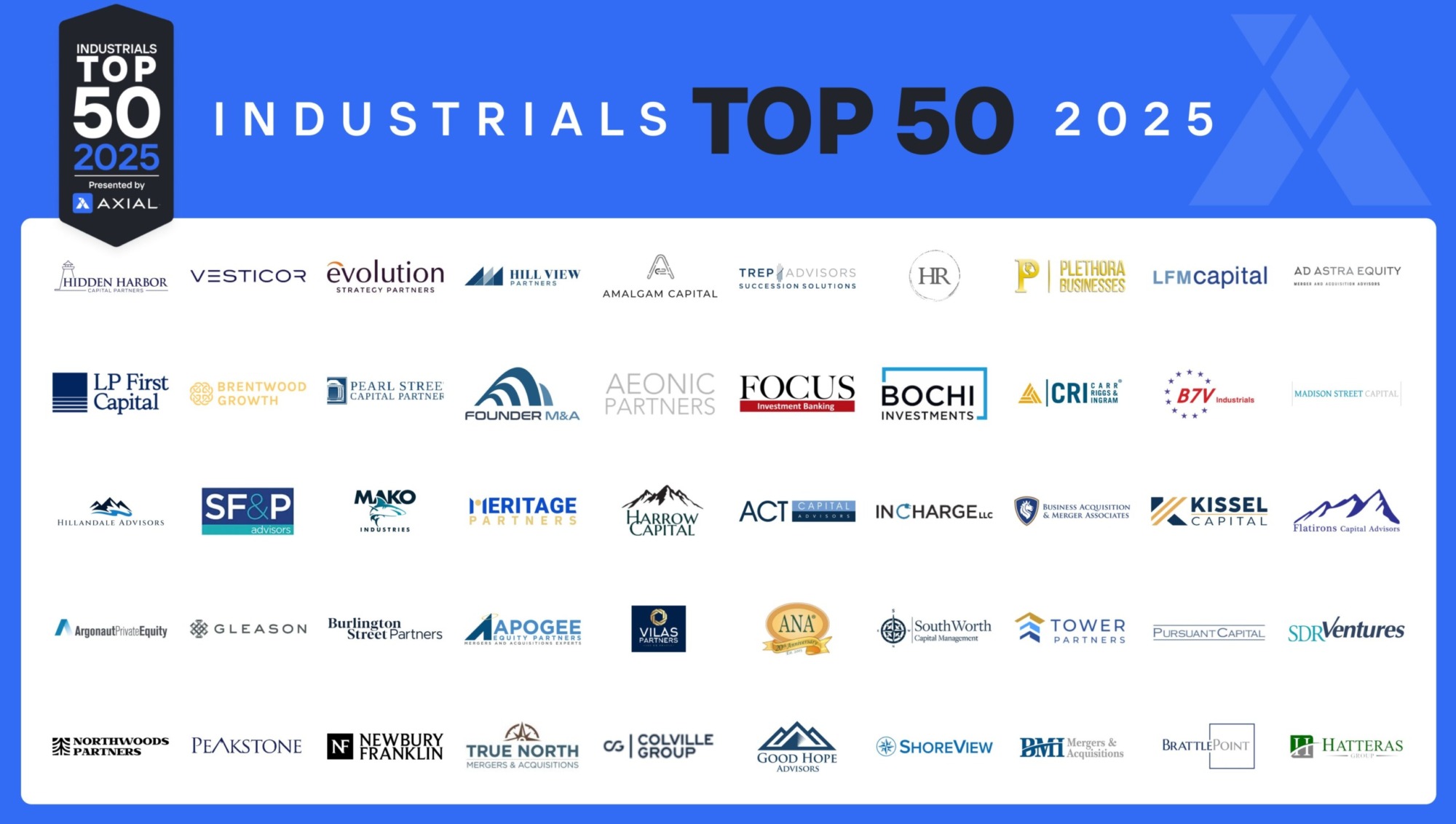
The Top 50 Lower Middle Market Industrials Investors & M&A Advisors [2025]
Industrials remains the most dominant sector in Axial deal flow, representing more than 25% of all deals brought to market…

Savage Services is a multi-billion dollar privately held company with 4,000 employees and a very active acquisition strategy. The company operates in three main sectors: agriculture, energy/chemicals, and environmental services. Sam Orme has been vice president of corporate development for nearly six years, in which time the company has made 21 acquisitions and EBITDA has more than tripled. MMR talked to Sam about the one thing that will kill a deal every time, the importance of focus in corporate development, and more.
There really was not a clear “corporate development” strategy before I came onboard and the company decided to make acquisitions a focus area. It was more, if the phone rang we would look at the opportunity. Shortly after I joined, we put together a focus area of where our best growth opportunities are based on our competitive advantages and the growth aspects of that segment.
We do have some businesses that frankly don’t grow. They’re GDP minus. If you think of coal handling, for instance, we’re not going to do many acquisitions in that sector. It’s not growing. But environmental services, for example, is a big focus because it’s growing north of GDP by a fairly nice rate, and we think we have a competitive advantage in certain segments.
We’ve chosen three focus areas for acquisitions right now. Any more than that ends up being overwhelming. For now its environmental services, marine transportation and logistics, and any other form of rail transloading. The companies we’re looking at are typically between two and 10 million in EBITDA and preferably this is their first sale. We’re not looking to buy from a private equity fund. We have, but we’d rather not.
If something outside our focus area comes in the door, we’ll take a look. But in terms of proactive acquisition strategy, we’ve got to be focused. If we’re not focused, it’s not going to be effective.
We find companies through Axial and we also have our own outreach efforts. We have a very active cold-calling effort, for lack of a better word. There’s conferences and events. The moment you stop filling the pipeline, deal flow immediately stops. A lot of times you get bogged down on a deal. I may not hit the road for three or four months. Guess what? I’m not seeing a deal for four or five months, and it’s my fault.
The moment you stop filling the pipeline, deal flow immediately stops.
Yes. Obviously, Axial helps keep us alive when we’re not on the road. But that’s why you have to do it as a team. Similar to an investment bank, I have an associate and an analyst working with me. One of them ends up being more the marketing person and the other ends up being the financial modeler person, depending on what their skill sets are best tailored to.
One of the most important parts of my job is building relationships with all of the key industry vertical presidents within Savage. If we buy something in their segment, we want to have confidence that they will run it properly and do a good job, and grow that business that you acquire. Any business that you buy as the head of corporate development, you’ve got to have full team buy-in. If it’s not a clear yes, it’s a clear no.
If it’s not a clear yes, it’s a clear no.
If the unit leader wants the deal more than me, then I know I have a good deal. If he or she is waffling, then I know I need to walk away. It’s tough, because sometimes that industry leader may be so focused on a customer or a project that he or she is not seeing the bigger picture. But regardless of the reason, if you don’t have buy-in from that person the deal is dead.
You bet. Of the 21 acquisitions there’s three or four that I’m not proud of. There have been others that have been absolute home runs, but there are a few that we’ve had for four years that still haven’t grown or have decreased. Those generally are cases where we didn’t do a good job of understanding the unit leader. Times when we’ve forced an acquisition on a unit leader, it’s been a total disaster. We know we got a great deal but it doesn’t matter if the leader hasn’t drank the Kool-Aid.
It’s taken us two years for most of these deals to realize we made a mistake. I wish we could figure it out in a shorter time frame. But it seems to take about two years to play out.
The deals that have been home runs have been done in the six to eight times multiple range, with solid management that wants to stay involved, and where we bring synergies from the Savage corporate parent from a customer perspective. When we’ve been able to buy deals cheaper, a lot of times there’s a reason it’s selling for cheaper. The company has a lot of issues and those turnarounds are never as easy as you think. It’s also really hard to make up for overpaying. You just never get the return, and you always feel sick in your stomach. It’s never fun.
We bought a company called EnviroServe in Cleveland last year. It does transportation and waste profiling for industrial facilities. They’ve been around for 20+ years and have a great management team. The father George had brought his sons in to help run it and they’re all fantastic. George was getting to retirement age and he wanted to sell the company to someone who was going to take care of his employees.
We reached out to them and started discussions. Ultimately we got to a deal that was a lot more than we wanted to pay — probably a full turn of EBITDA above what I thought was fair. But that’s what it took to get a deal done. And the reason we were willing to do it was because we were confident we could bring synergies to the table. We own another environmental business called SunPro in Canton, OH, which does emergency response cleanup — when there’s a spill on the highway or a rail car crashes, they go in and clean that spill up.
EnviroServe wasn’t doing any emergency response cleanup so immediately after the acquisition, we married SunPro’s cleanup crews with EnviroServe’s customer base. We have seen an enormous amount of synergy between those two companies, where we cross-pollinate the customer base. We can utilize the waste profiling and transportation expertise of EnviroServe with the emergency response and manpower of SunPro. Even though we paid more than we thought was fair, it’s been a great deal for us.
Yes. We have a regional expansion strategy in the environmental services market. For example, even though we’re headquartered in Salt Lake City we’re probably not going to do an environmental deal there because there’s no synergy with our existing environmental footprint, which is mostly in the rust belt.
I love the hunt. To be a good corporate development person you have to love putting hay in the barn and going out and finding something, bringing it in, and working with your team to do that. You’ve got to have that inner desire to go out and hunt, because finding deals these days I think is harder than ever, given how much money is out there and how much money is chasing the good deals.
If you don’t prioritize your calling efforts, someone else will. It’s easy to get distracted, whether it’s by a deal that comes from an investment banker that kind of looks interesting or a greenfield opportunity that as the corp-dev individual you’re going to get dragged into. You really need to stick to that goal that you set every year — “I’m going to buy an emergency response company in the rust belt with at least $3 million of EBITDA in the next 12 months.”
Those goals need to be that specific. Working for a huge corporation, you are going to get distracted. You’ve got to prioritize your focus and prioritize the hunt.
